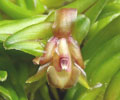|
|
|
|
|
| |
Flasks of
Epidendrum schlechterianum 'Minnie Mouse' × self |
|
| |
|
|
| |
|
|
Click to Enlarge

Pod Parent Flower |
Click to Enlarge

Pod Parent Blooming Plant |
|
|
|
| |
Culture Notes from Donor: Parent plant: Temperature range W (70-90°F). It is growing on cork with a bit of sheet moss around the root area. It enjoys good light but shouldn't be placed in full sunlight. I grow and bloom it in bright partial shade, good humidity.
Comments: Parent plant: Plant is from Panama. Epidendrum schlechterianum is a miniature reedstem with an equitant growth habit native to humid forests at lower altitudes from Mexico to northern South America. It is considered uncommon within its range. Schlechterianum is occasionally found as a lithophyte, but most typically is epiphytic. A mature plant may reach as much as 6 cm (2.5 inches) in overall height. It blooms apically in the Northern Hemisphere in the early spring, with one or two flowers. The very fleshy flowers are surprisingly large for the size of the plant, measuring up to 3 cm in length.
For additional origin/habitat information supplied courtesy of
Charles and Margaret Baker, see further below, near the bottom of this page.
|
Temperatures we attempt to use in the lab & greenhouse:
| For Species: |
|
Spring, Summer, Autumn, Winter: days average 88°F, nights 71°F; best fit is Warm 90-70°F
(Source:
Baker's Web OSC) |
| For Species: |
|
Winter: days average 80°F, nights 63°F; best fit is Intermediate 83-60°F
(Source:
Baker's Web OSC) |
|
About the name...
| Etymology of |
Epidendrum |
|
From Greek "epi" upon; "dendron" tree.
(Source:
Pridgeon 1992) |
| Etymology of |
schlechterianum |
|
Named for F. R. Rudolf Schlechter (1872-1925), renowned German botanist who traveled to Africa, New Guinea, and parts of Melanesia, and who described more than 1000 new species, established numerous genera, and published a standard textbook of German orchidology usually called "The Schlechter."
(Source:
Mayr & Schmucker 1998) |
| Pronunciation of |
Epidendrum |
|
eh-pee-DEN-drum
(Source:
Pridgeon 1992) |
| Pronunciation of |
schlechterianum |
|
shlek-ter-ee-AH-num
(Source:
Hawkes 1978) |
|
If you would like to direct someone to this web page, please copy and paste this URL into your email:
http://troymeyers.com/d?013811
| Flask Information |
| Availability: |
Capsules failed. We were not able to make any flasks. |
| You should: |
Consider placing a "Notify Retries" Request, and if an identical pollination (the same parents) is done again, we'll let you know. |
|
You might also want to:
|
View items of the same species.
View items of the same genus.
|
| Ordering Information |
| You are not currently logged in. |
|
You must be a registered user and be logged in to reserve a flask or place a notification request. Please log in:
|
|
|
|
|
|
| |
The origin/habitat information below is supplied courtesy of Charles and Margaret Baker
The following information is based on the name of the plant provided by the donor, and assumes that the name is correct. If the plant has been misidentified, then the following information may not be correct.
This text is copyrighted by the Bakers and may not be reproduced without permission.
ORIGIN/HABITAT: From the States of Guerrero and Oaxaca in Mexico southward
through Guatemala, Honduras, Nicaragua, Costa Rica and Panama to the West
Indies, Surinam (Dutch Guiana), Brazil and Peru. These plants grow on
mossy rocks and trees in open or dense humid forests. Although collections
have been reported generally from near sea level to 3600 ft.(1100 m), most
seem to be made near 1000 ft. (300 m). In Costa Rica, however, collections
have been made near San Jose at 4600-5250 ft. (1400-1600 m)
More about this information and the Bakers...
|
|
|
| |
|
|
|